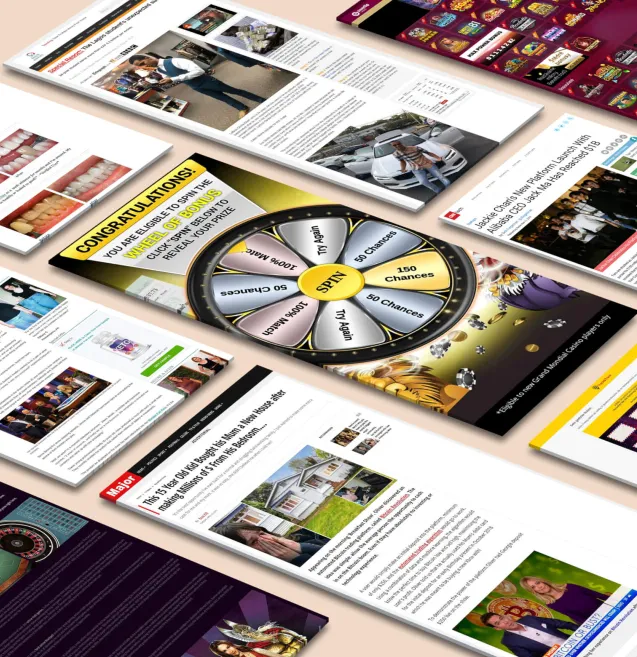
Our spy tools monitor millions of native ads from over 60+ countries and thousands of publishers.
Get StartedCreating seasonal marketing campaigns is a powerful strategy to capture your audience's attention during specific times of the year. These promotions take advantage of consumer behavior patterns, aligning your brand with holidays, cultural events, and seasonal celebrations.
Your marketing success depends on your ability to create campaigns that resonate with customers during these peak periods. A well-executed seasonal campaign can:
In this guide, you'll discover 10 creative seasonal marketing strategies designed to boost your engagement rates and transform casual browsers into loyal customers. Each strategy provides actionable steps to enhance your seasonal marketing efforts.
Ready to elevate your seasonal marketing game? Let's explore these proven techniques to create campaigns that captivate your audience and drive results during the most important times of the year.
Seasonal marketing transforms your brand's presence by aligning promotional activities with specific times of the year. This strategic approach taps into the natural rhythm of consumer behavior, creating targeted campaigns that resonate with your audience's current needs and mindset.
Your customers experience heightened emotional states during different seasons and holidays. By crafting marketing messages that reflect these emotional peaks, you create deeper connections with your audience:
Your seasonal marketing strategy becomes particularly effective when you combine authentic storytelling with timely promotions. Brands like Starbucks demonstrate this through their Pumpkin Spice campaign, which has evolved from a simple seasonal drink to a cultural phenomenon that customers eagerly anticipate each fall.
Strategic timing of marketing campaigns can make or break your seasonal success. The key lies in identifying holidays and events that resonate with your target audience. Major retail events like Black Friday and Cyber Monday drive significant consumer spending, while cultural celebrations such as Christmas, Valentine's Day, and Halloween create emotional purchase triggers.
Smart timing strategies include:
Real-world success: Nike's "Singles Day" campaign in China generated $500 million in sales by timing their promotion perfectly with the cultural phenomenon. Starbucks' annual "Red Cup Season" builds anticipation weeks before the holiday season, creating a cultural moment that drives sales through seasonal exclusivity.
You'll maximize engagement by studying your audience's buying patterns and planning campaign launches during peak shopping periods. Data shows consumer spending typically increases 15-30% during major holidays, presenting prime opportunities for targeted promotions.
Your brand's visual identity needs seasonal adjustments to resonate with your audience's current mindset. A successful seasonal marketing campaign integrates holiday-specific elements while maintaining brand recognition.
Key Visual Elements to Customize:
Brand Consistency Tips:
Your seasonal messaging should reflect the emotional context of the holiday. Christmas campaigns often focus on giving and family, while summer promotions emphasize adventure and freedom. Nike's "Find Your Greatness" campaign successfully adapts its messaging across seasons while keeping its empowerment theme consistent.
Visual Adaptation Examples:
Time-sensitive promotions tap into your customers' fear of missing out (FOMO). You can create this sense of urgency through:
Holiday bundle deals combine complementary products to increase average order value. Consider these proven combinations:
Strategic scarcity tactics drive immediate action:
Pro tip: Test different time windows for your limited-time offers - some audiences respond better to 48-hour sales while others need a week to make decisions.
Transform your seasonal campaigns into memorable experiences with interactive elements that captivate your audience. Create digital advent calendars revealing daily deals, host holiday-themed quizzes testing product knowledge, or launch seasonal photo contests encouraging user participation.
Proven Interactive Elements:
These gamified experiences drive significant results:
Pro tip: Design your interactive content to align with mobile users - 73% of gamified experiences are accessed through smartphones.
Boost participation by incorporating seasonal themes into your rewards structure. Award points for holiday purchases, create themed achievement badges, or implement special seasonal challenges that unlock exclusive rewards.
Your loyalty program can become a powerful seasonal marketing tool with strategic enhancements during peak shopping periods. Consider these proven tactics:
These targeted benefits create a sense of exclusivity while driving repeat purchases during crucial seasonal periods. You'll notice increased customer participation as they rush to maximize their seasonal rewards.
Moreover, incorporating insights from your loyalty program's analytics can significantly enhance your marketing strategy. For instance, by tracking customer behavior patterns, you can identify popular seasonal product combinations, peak shopping times during holiday periods, preferred reward redemption patterns, and customer gift-giving preferences. This valuable data helps shape personalized marketing strategies for future seasonal campaigns.
To further amplify the effectiveness of your loyalty program during these peak times, consider leveraging native advertising. By understanding your competition and their successful strategies, you can build winning native advertising campaigns that get more for your advertising spend. With such comprehensive insights and targeted promotions, your loyalty program becomes both a customer retention tool and a rich source of actionable insights for maximizing your seasonal campaigns.
Effective seasonal marketing requires precise audience segmentation to deliver personalized experiences that resonate with different customer groups. You can segment your audience based on:
Create targeted email campaigns and social media ads that speak directly to each segment's needs. A parent shopping for children's gifts requires different messaging than a professional seeking corporate holiday presents. Your segmentation strategy should adapt throughout the season, tracking real-time engagement data to refine your approach and maximize conversion rates.
Social media platforms offer powerful opportunities to showcase your seasonal campaigns through visually striking content. Create eye-catching Instagram Stories with holiday-themed filters, animated GIFs, and festive stickers to capture your audience's attention. Design Pinterest-worthy infographics featuring gift guides, seasonal recipes, or holiday decoration tips.
Proven social media tactics include:
Boost user engagement through:
Transform your social media presence into a festive hub by maintaining consistent posting schedules and responding promptly to customer interactions. Leverage platform-specific features like Instagram's shopping tags or Facebook's seasonal frames to enhance your campaign's reach and impact.
Successful seasonal marketing requires meticulous planning months before your campaign launch. You'll need to coordinate your marketing assets across multiple channels:
Start your planning process 3-6 months ahead to allow time for:
A well-planned multi-channel approach ensures your message reaches customers at every touchpoint while maintaining brand consistency throughout the seasonal campaign.
Your website's performance during peak seasonal traffic can make or break your campaign success. A robust infrastructure acts as the backbone of your seasonal marketing efforts.
Essential Infrastructure Optimization Steps:
Streamlined Checkout Process:
A well-optimized website infrastructure helps maintain consistent performance during seasonal peaks. Major retailers like Amazon and Walmart invest heavily in their technical infrastructure months before Black Friday to handle millions of simultaneous shoppers. To further enhance your seasonal marketing efforts, consider leveraging advanced Google Analytics techniques. These techniques can provide valuable insights into user behavior, helping you optimize your website and improve ROI during high traffic periods.
Post-campaign analysis transforms your seasonal marketing data into actionable insights. You'll want to track key metrics including:
Your analysis should identify successful campaign elements and areas needing improvement. Compare performance against previous seasonal campaigns to spot trends and patterns in customer behavior. This data helps you:
Create a detailed report documenting these insights for reference when planning future seasonal campaigns. Include specific examples of what worked well and what didn't, backed by concrete data and customer testimonials.
Customer Feedback Collection Methods:
Seasonal marketing campaigns thrive at the intersection of creativity and strategic planning. The 10 strategies outlined here provide a robust framework for businesses ready to amplify their seasonal engagement efforts.
Key Success Factors:
Your seasonal marketing success depends on finding the right balance between creative expression and methodical execution. Start by implementing these strategies gradually, measure their impact, and refine your approach based on real results.
Remember: Effective seasonal marketing isn't just about following trends - it's about creating meaningful connections with your audience during moments that matter most to them.
Ready to transform your seasonal marketing efforts? Take the first step by selecting one strategy that aligns with your immediate business goals and start planning your next campaign today. Your customers are waiting to engage with your brand's unique seasonal story.
Receive top converting landing pages in your inbox every week from us.
Announcement
Predicting winning offers separates profitable affiliates from those barely breaking even. You need to know which products will convert, when they'll perform best, and who will buy them. Traditional methods rely on historical performance and gut feelings. AI-powered affiliate tools eliminate this guesswork by analyzing real-time signals—from browsing patterns to seasonal trends—and forecasting which offers will generate the highest returns. This shift from reactive testing to proactive selection transforms how you build campaigns and dramatically impacts your bottom line.
Marcus Chen
7 minNov 13, 2025
Tips & Tricks
Dropshipping has transformed e-commerce by allowing you to sell products without holding inventory. You partner with suppliers who ship directly to your customers, eliminating warehousing costs and operational complexity. This business model continues gaining momentum as entrepreneurs seek flexible, location-independent income streams.
Samantha Reed
7 minNov 12, 2025
Tips & Tricks
In-stream ads are video advertisements that play before, during, or after your streaming content on platforms like YouTube, OTT services, and social media channels. These ads represent a critical revenue stream in TikTok-ads-payment-problems-how-to-add-a-payment-method digital advertising, particularly as more viewers shift from traditional TV to streaming platforms. You're essentially capturing your audience's attention while they're already engaged with video content—making it one of the most effective advertising formats available today.
Dan Smith
7 minNov 11, 2025




